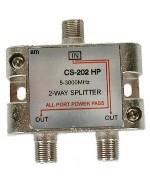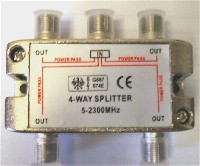Post by Forum Admin on Aug 18th, 2011 at 7:03pm
If you want to merge the output from two HPAs into one waveguide you need either:
1. A 3 dB hybrid coupler and dummy load.
The coupler has 4 ports. Two ports for inputs, one port for the merged output and one port for the dummy load. Note that you will lose half your entire power in the dummy load.
The use of a device like that below will allow two BUCs to be operated simultaneously, each with a different transmit carrier from its own modem and the output at 14 GHz combined.
Read more: https://www.atmmicrowave.com/wave-combiner.html
Unfortunately there is a 3 dB loss, so only half of the power from each BUC will reach the feed.
Choose a coupler that works over the bandwidth you require.
You also need a suitably rated finned dummy load to terminate the other half of the total power at the unused port.
Read more: https://www.credowan.co.uk/waveguide-loads.htm
Search Google for waveguide couplers and waveguide loads. Explain to the suppliers exactly what you want to do and get their assurance as to suitability of the proposed parts.
2. A filter combiner or diplexer
This works if the carriers from the two HPAs are well apart in frequency. There is minimal dB loss but high cost. This is the solution used on satellites to combine the output from several HPAs into one downlink beam polarisation.
The principle is the same as that used for a co-pol VSAT feed where transmit and receive are on the same polarisation. For VSAT operation the two waveguides operate far apart in frequency, like 3.4-4.2 GHz and 5.9-6.4 GHz. Trying to operate say 6.3-6.4 and 6.6-6.7 is far more difficult and expensive. A band-pass/band-stop filter is needed in each HPA port and these filters also need to block the other frequency. These filters may well be very expensive.
If you really need two carriers and have a 4 port feed what not ask the satellite operatior if they can lease you some capacity on the other polariation, then you can connect the second HPA direct to the other feed TX port?
Best regards, Eric.
1. A 3 dB hybrid coupler and dummy load.
The coupler has 4 ports. Two ports for inputs, one port for the merged output and one port for the dummy load. Note that you will lose half your entire power in the dummy load.
The use of a device like that below will allow two BUCs to be operated simultaneously, each with a different transmit carrier from its own modem and the output at 14 GHz combined.
Read more: https://www.atmmicrowave.com/wave-combiner.html
Unfortunately there is a 3 dB loss, so only half of the power from each BUC will reach the feed.
Choose a coupler that works over the bandwidth you require.
You also need a suitably rated finned dummy load to terminate the other half of the total power at the unused port.
Read more: https://www.credowan.co.uk/waveguide-loads.htm
Search Google for waveguide couplers and waveguide loads. Explain to the suppliers exactly what you want to do and get their assurance as to suitability of the proposed parts.
2. A filter combiner or diplexer
This works if the carriers from the two HPAs are well apart in frequency. There is minimal dB loss but high cost. This is the solution used on satellites to combine the output from several HPAs into one downlink beam polarisation.
The principle is the same as that used for a co-pol VSAT feed where transmit and receive are on the same polarisation. For VSAT operation the two waveguides operate far apart in frequency, like 3.4-4.2 GHz and 5.9-6.4 GHz. Trying to operate say 6.3-6.4 and 6.6-6.7 is far more difficult and expensive. A band-pass/band-stop filter is needed in each HPA port and these filters also need to block the other frequency. These filters may well be very expensive.
If you really need two carriers and have a 4 port feed what not ask the satellite operatior if they can lease you some capacity on the other polariation, then you can connect the second HPA direct to the other feed TX port?
Best regards, Eric.



